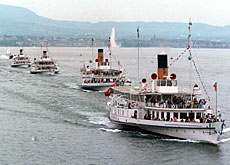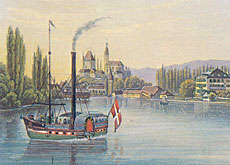Swiss take pride in Belle Epoque steamers

For 100 years, paddle steamers have been plying the Swiss lakes. More than mere modes of transport, they have become part of the country's heritage.
Although their charm is widely appreciated, keeping the steamers shipshape is no easy matter.
“When we work on a boat like this, we have to approach it with great care,” said Jean-Marc Naucelle, in charge of restoration work on “La Suisse”, the flagship of the General Navigation Company (CGN) of Lake Geneva.
Squeezed into a dry dock in Lausanne harbour, the steamer reveals its generous proportions – 78 metres long, 15 metres wide and with a capacity of 1,200 passengers.
“We haven’t had any major surprises concerning the state of the hull,” Naucelle said. “But the steel plates are not very thick [6mm], and if this was a sea-going vessel, the salt would have totally corroded it by now.”
Zurich beginnings
Like the other 11 boats ordered by the company between 1904 and 1927, “La Suisse” was built in the Sulzer workshops in Winterthur.
CGN and the Zurich firm Escher-Wyss built most of the steamers that still ply the Swiss lakes, as well as the Rhine, Rhone and Danube rivers, and the Italian and French lakes.
The two big paddles give the steamer its characteristic silhouette, as well as its stability and propulsion.
Like many of its sister ships, “La Suisse” has a flat underside with a small keel and a draught of less than two metres.
Thun, Brienz, Constance and Zurich
With eight boats on Lake Geneva, five on Lake Lucerne, two on the lakes of Thun and Brienz, one on Lake Constance and two on Lake Zurich, Switzerland is exceptionally well endowed with Belle Epoque boats.
It is a flotilla that can be considered unique in the world, and which includes the tiny 22-passenger “DS Greif”, which is used for cruises on the Greifensee just outside Zurich.
Built in 1895, it proudly holds the title of the oldest steamboat in Switzerland.
Wave of modernisation
It was the navigation firms’ lack of money rather than any desire to hold on to these Belle Epoque treasures that ultimately saved the old steamers.
“The CGN was making a profit until the 1920s,” explained Didier Zuchuat, secretary of the Lake Geneva Heritage Association. “But since it was a binational company [with France], it didn’t receive any public funding until new boats had to be constructed for the National Exhibition of 1964.”
At the time, paddle steamers suffered from the enthusiasm for all things modern. Contemporary elements were added, which gradually eroded their original appearance.
As a result, during the 1950s the company replaced the steam engines on three of its vessels with diesel ones.
National heritage
Towards the end of the 20th century, the winds changed. In 1999, the Lake Geneva Heritage Association had the steamers listed as items of national heritage.
“The people living next to Lake Geneva see these boats all the time and could not imagine them disappearing,” said Zuchuat.
The three cantons of Vaud, Valais and Geneva understood the need to preserve the steamers and now contribute around SFr5 million per year, which covers about a quarter of the company’s costs.
“It’s clear that it would cost virtually nothing if we gave up the paddle steamers,” explained CGN director Luc-Antoine Baehni. “But our role is not just to transport passengers; we also have a part to play in tourism and national heritage.”
Urgency
Despite financial support from the public, the flotilla of Swiss boats must count on other, private, sources.
Apart from the “Montreux”, which was entirely rebuilt in 1988 – and which got back its steam power – the CGN boats have at best a life expectancy of 30 years.
And the situation is no better on other Swiss lakes. In Zurich, “Stadt Zurich” and “Stadt Rapperswil” are awaiting urgent renovation work, and the only steamer on Lake Constance is used for private cruises only
Therefore, the support of associations like the Lake Geneva Heritage Association or the Friends of Steamers on Lake Geneva, is welcome.
Contemporaries of the Titanic
Their aim is not only to keep these venerable boats afloat, but also to give them back some of their original lustre.
Contemporaries of the Titanic, these boats were originally floating palaces, with richly furnished lounges, wooden fittings and figureheads.
For the steamer season, which is due to get underway shortly, “La Suisse” once again sports a wooden figurehead on her bow and has recovered one of her original lifeboats.
Even if they cost twice as much to run as modern propeller-driven boats, the Belle Epoque steamers still seem to have plenty of life in them yet.
swissinfo, Marc-André Miserez (translation: Samantha Tonkin)
With 19 steamers in operation, Switzerland has around a quarter of the world’s functioning paddle steamers.
The majority of steamers in Switzerland were built between the end of the 19th and beginning of the 20th century by two Zurich firms.
The most important flotilla belongs to Lake Geneva (eight boats) and is an important part of Swiss heritage.
The steamers are expensive to run and maintain, and private and public support are needed.
The presence of steamers on Swiss lakes is important for tourists and locals alike.

In compliance with the JTI standards
More: SWI swissinfo.ch certified by the Journalism Trust Initiative










You can find an overview of ongoing debates with our journalists here . Please join us!
If you want to start a conversation about a topic raised in this article or want to report factual errors, email us at english@swissinfo.ch.